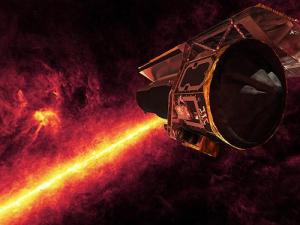Astronomers map the history of the Universe
British astronomers are trying to expand our knowledge of the history of the Universe with a new project to understand the beginning and formation of galaxies.
Using NASA's Infrared Camera on Spitzer Space Telescope, the Spitzer galaxy survey program (SERVS) will create an extremely large map of the sky, capable of detecting very faint galaxies. The primary goal is to graph the distribution of stars and black holes since the Universe is less than a billion years old until now.
This survey is one of the programs that have the longest observation time on a space observatory - a total of 1400 hours.
The project leader, Dr. Mark Lacy, now works at the Spitzer Science Center at Caltech, but will soon be moving to the University of Southampton, saying: 'This mid-range infrared survey compensates for the lack of wavelengths. between near-infrared surveys conducted by British groups, and far infrared surveys conducted by Herschel and SCUBA-2. It will for the first time allow us to study the formation and development of large galaxies like the Milky Way galaxy on the cosmic scale. "
Dr. Duncan Farrah of the University of Sussex, his research, funded by the Council of Science and Technology, said: 'This may be the standard for near-infrared survey in the next decade. The excellent latency of SERVS data means that we can detect mid-mass galaxies when the Universe is 8% of its current age. The combination of SERVS data and data from the Herschel spacecraft also means that we can observe quite old stars, growing stars and explosions of dusty star formation. Since then we have obtained a complete picture of the early galaxy formation of the Universe '.
 The illustration of Spitzer's painter is seen in the infrared sky. The light in the image is the glowing dust emitted from the Milky Way galaxy at a rate of 100 micrometers. (Photo: NASA / JPL-Caltech)
The illustration of Spitzer's painter is seen in the infrared sky. The light in the image is the glowing dust emitted from the Milky Way galaxy at a rate of 100 micrometers. (Photo: NASA / JPL-Caltech)
The combination of sensitivity and area surveyed by SERVS is unprecedented; Sensitivity means that galaxy formation can be studied when the Universe is very young, while the wide area means that these formation processes can be studied under the basic distribution of matter. 'dark'.This feature will be strengthened by coordination with observations from carefully planned other devices.
Carefully selected spatial areas to fit into the spatial areas will have a deep image from the Herschel Space Observatory, SCUBA-2 camera on Maxwell (JCMT) James Clark Telescope and words Video survey of VISTA galaxies origin.
Each of these devices provides a different aspect of galaxy formation. The combination of data on multiple wavelengths means that we will get a complete picture of the development of the galaxy, no longer part of this process of being 'hidden' by the impact of dust Space.
Dr. Seb Oliver of the University of Sussex said: 'It is great to see the top astronomical devices both on the ground and in space working together to answer basic questions about formation. and galaxy development '.
Dr. Matt Jarvis of the University of Hertfordshire added: 'The combination of SERVS and VIDEO will allow us to conduct a full study of galaxy development through the history of the Universe. However, the main progress compared to the surveys has been the combination of depth and coverage, allowing us to conduct research in the densest and sparsest areas of Vu. cylinder. This will be the premise for building an overall picture of galaxy formation and development under the impact of the surrounding environment . '
The survey will be conducted in early 2009, the international year of astronomy (IYA2009) . With the participation of more than 140 countries in the world, and with events held nationally, regionally and globally this year, IYA2009 will not only allow us to observe the heavenly bodies. amazingly formed the Universe, but also provided a number of diverse events and projects, from astronomical exhibitions to virtual blog interaction.
- Published the largest universe history map ever
- Universe image from the corner of the garden conquered astronomers
- Astronomers compiled the most detailed 3D universe map
- Space History will be rewritten?
- The 'newborn' of the universe
- The bright galaxy takes the scientist to the early universe
- New hypothesis of cosmic formation
- The universe is cooling down
- Great milestones in the history of conquering the universe
- The universe in human thinking through the ages
- The universe is in crisis
- Capture the most distant object in the universe
 Van Allen's belt and evidence that the Apollo 11 mission to the Moon was myth
Van Allen's belt and evidence that the Apollo 11 mission to the Moon was myth The levels of civilization in the universe (Kardashev scale)
The levels of civilization in the universe (Kardashev scale) Today Mars, the sun and the Earth are aligned
Today Mars, the sun and the Earth are aligned The Amazon owner announced a secret plan to build a space base for thousands of people
The Amazon owner announced a secret plan to build a space base for thousands of people